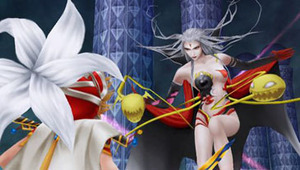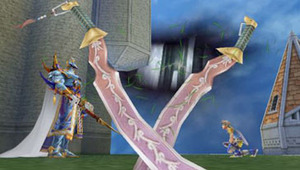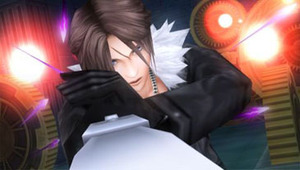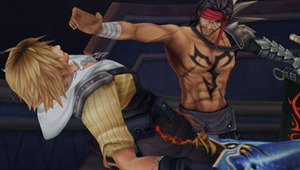
bit-tech: What is it that you think makes Dissidia unique in the crowded genre of fighting games?
Takeshi Arakawa: Roughly speaking, I think there are three things that make Dissidia stand out from other fighting games. One is that most fighting games are obviously 2D, but Dissidia isn’t. In our game characters can fly in the sky or use the terrain to interact with the environment and climb walls and so on.
The second thing is that Dissidia has a very strong story mode that you can use to practice and strengthen your characters before using them in multiplayer battles. You can level them up in story mode and then use in multiplayer, but even if you take on a much stronger or weaker opponent in the game then it can't have too much of a negative effect on the battle results because of the bravery system. The bravery system is definitely what makes Dissidia unique.
BT: Can you tell us about more about the bravery system and how it works then?
TA: Well, in ordinary fighting games you inflict damage directly. You knock off their health until they reach zero and then you win. In Dissidia it isn’t like that; you have to store up what we call brave points and only then, when your attack is successful, the damage is inflicted. Also, in many cases, you can use some of your summons, which you might be familiar with from previous games.
A player who learns to use the system and all these sorts of attacks is at an advantage, obviously. So, even if your level is lower than an opponent's, you can make good use of brave points and summons and still have a chance to win.
BT: OK, so, why did you decide to launch on the PSP and focus in on that market, rather than the Nintendo DS or even the PlayStation 3?
TA: Um, well obviously the main feature of the game is the multiplayer 3D action and if we were going to do that on the PlayStation 3 or a larger console then we’d have to use split-screen, which wasn’t what we wanted.
Instead, we decided we wanted to try to develop this game on a handheld console – which left the DS and the PSP. Being a Square Enix game, we felt we had to offer really good graphics, so that narrowed the choice down to just the PlayStation Portable. The PSP is just far superior for graphics.
BT: Do you think there’s a split in the way the PSP is viewed as a platform in Japan and in the US or UK? Over here the PSP is nowhere near as popular as it might be in Japan.
TA: Well, even in Japan the PSP hasn’t even outsold the PlayStation 3. With the PlayStation 3 though we wouldn’t have really been able to achieve what we wanted. We decided in the end to give higher priority to what the creators want to do rather than to the marketing strategy.
BT: So, it’s not likely that we’ll see a full console release eventually?
TA: <laughs> No. We have no plans for that.
BT: There’s been recurring mention of piracy on the PSP, even with Sony admitting that piracy is rampant on the platform. Is that something you’re worried about when developing for the platform?
TA: Yes. <laughs> We’re worried about the issue...extremely worried, really. The issue of piracy is quite a concern, on the PlayStation as well as on the PSP, but our basic stance is that although it is unfortunate, there really isn’t a lot we can do. What’s done is done.
What we do is stick to a policy of creating games that the player will feel very proud of owning, so that even if you could pirate the game then you’ll still be persuaded to purchase it. As long we can continue to do that...
BT: Certainly – and piracy hasn’t seemed to have hurt the Japanese sales that much either.
TA: Hmm...Well, the piracy has been quite a problem in Japan too. It’s getting to be really very bad, but Dissidia has proven quite a success in Japan for two reasons, I think. First, it came out at Christmas and people were more willing to prepared at that time. Second, the series has been running for 20 years now, so we’ve got quite a lot of fans who don’t mind paying a bit of money to support us.
Takeshi Arakawa: Roughly speaking, I think there are three things that make Dissidia stand out from other fighting games. One is that most fighting games are obviously 2D, but Dissidia isn’t. In our game characters can fly in the sky or use the terrain to interact with the environment and climb walls and so on.
The second thing is that Dissidia has a very strong story mode that you can use to practice and strengthen your characters before using them in multiplayer battles. You can level them up in story mode and then use in multiplayer, but even if you take on a much stronger or weaker opponent in the game then it can't have too much of a negative effect on the battle results because of the bravery system. The bravery system is definitely what makes Dissidia unique.
BT: Can you tell us about more about the bravery system and how it works then?
TA: Well, in ordinary fighting games you inflict damage directly. You knock off their health until they reach zero and then you win. In Dissidia it isn’t like that; you have to store up what we call brave points and only then, when your attack is successful, the damage is inflicted. Also, in many cases, you can use some of your summons, which you might be familiar with from previous games.
A player who learns to use the system and all these sorts of attacks is at an advantage, obviously. So, even if your level is lower than an opponent's, you can make good use of brave points and summons and still have a chance to win.
BT: OK, so, why did you decide to launch on the PSP and focus in on that market, rather than the Nintendo DS or even the PlayStation 3?
TA: Um, well obviously the main feature of the game is the multiplayer 3D action and if we were going to do that on the PlayStation 3 or a larger console then we’d have to use split-screen, which wasn’t what we wanted.
Instead, we decided we wanted to try to develop this game on a handheld console – which left the DS and the PSP. Being a Square Enix game, we felt we had to offer really good graphics, so that narrowed the choice down to just the PlayStation Portable. The PSP is just far superior for graphics.
BT: Do you think there’s a split in the way the PSP is viewed as a platform in Japan and in the US or UK? Over here the PSP is nowhere near as popular as it might be in Japan.
TA: Well, even in Japan the PSP hasn’t even outsold the PlayStation 3. With the PlayStation 3 though we wouldn’t have really been able to achieve what we wanted. We decided in the end to give higher priority to what the creators want to do rather than to the marketing strategy.
BT: So, it’s not likely that we’ll see a full console release eventually?
TA: <laughs> No. We have no plans for that.
BT: There’s been recurring mention of piracy on the PSP, even with Sony admitting that piracy is rampant on the platform. Is that something you’re worried about when developing for the platform?
TA: Yes. <laughs> We’re worried about the issue...extremely worried, really. The issue of piracy is quite a concern, on the PlayStation as well as on the PSP, but our basic stance is that although it is unfortunate, there really isn’t a lot we can do. What’s done is done.
What we do is stick to a policy of creating games that the player will feel very proud of owning, so that even if you could pirate the game then you’ll still be persuaded to purchase it. As long we can continue to do that...
BT: Certainly – and piracy hasn’t seemed to have hurt the Japanese sales that much either.
TA: Hmm...Well, the piracy has been quite a problem in Japan too. It’s getting to be really very bad, but Dissidia has proven quite a success in Japan for two reasons, I think. First, it came out at Christmas and people were more willing to prepared at that time. Second, the series has been running for 20 years now, so we’ve got quite a lot of fans who don’t mind paying a bit of money to support us.

MSI MPG Velox 100R Chassis Review
October 14 2021 | 15:04













Want to comment? Please log in.